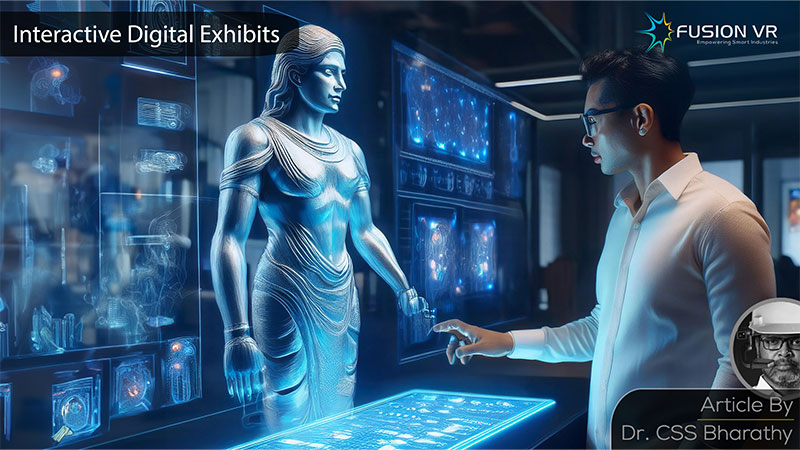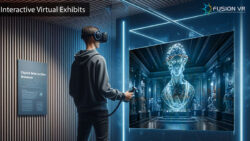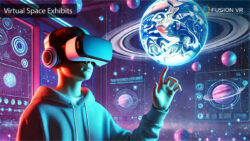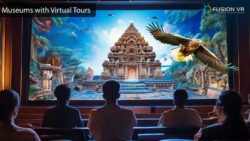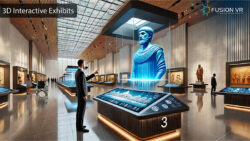There has been a complete change in museums over the last few years. Incorporating digital technology has completely transformed visitors’ engagement with the exhibits inside the museums. This transformation actually creates immersive experiences that mesmerize viewers like never before. As we step into 2024, the future of museums lies in digital museums that use advanced technology to improve visitor engagement and redefine their experience. This blog explores how digital interactive experiences, AR VR museums, and other technologies are shaping the future of museums, with a spotlight on Fusion VR’s innovative projects and success stories.
The Evolution of Museums: From Static to Interactive
Traditionally, museums have been seen as immobile archives of culture and history. But today the emergence of digital technology has changed them into dynamic environments that prioritise immersive interactions and sometimes provide live teleportation like experiences. This change is about more than just tossing in some technology; it’s about making museum visits more entertaining and enlightening.
Digital Interactive Experiences: Engaging the Modern Visitor
Interactive digital experiences are changing the way people engage with museum displays. These experiences rely on various technologies, including touchscreens interactive kiosks, AR, and VR. By allowing visitors to interact with exhibits, these technologies make the experience more personal and hands-on.
For example, Fusion VR’s recent project at the Kalaignar Memorial Museum in Tamil Nadu showcases the power of digital interactivity. Visitors can use AR to witness the history and legacy of the late Chief Minister M. Karunanidhi come to life, providing a vivid and educational experience that goes beyond traditional static displays. This blend of education and entertainment ensures that visitors of all ages remain engaged and inspired.
AR and VR Museums: Immersive Journeys through Time and Space
When it comes to museums, AR and VR are surely game changers that provide visitors with immersive experiences that take them to different places and eras. The physical displays are further enriched by AR which puts digital content over real objects in the realm of augmented reality. On the other hand, VR creates new environments for visitors to discover.
Virtual Reality Museum Experience is a classic demonstration of the possibilities contained in this technology. It allows its users to explore ancient India exploring historical sites and artifacts in a way that feels incredibly real. Aside from making your visit more interesting, it provides you with something more memorable that is to say, live through history rather than just reading about it.
Enhancing Visitor Experiences with Cutting-Edge Technologies
Beyond AR and VR, museums are incorporating cutting-edge technologies. Additionally essential to improving visitor experiences are big data, machine learning, and artificial intelligence (AI). With the use of these technologies, experiences can be customized and recommendations made based on the behavior and preferences of the visitor.
Fusion VR have effectively integrated these technologies. To make every visitor’s experience distinctive and captivating, these centers employ artificial intelligence (AI) to evaluate visitor interactions and deliver personalized information. This level of customization is essential in the current digital age, as users anticipate experiences that are tailored to their unique requirements and interests.
Conclusion
Digital museums are not a fad but a new mode of adopting cultural and historical promotion and presentation. Interactive technologies significantly affect the traditional museum environment by making it more active, focusing on the individual, and is experiencing the use of AR VR museums and other similar applications. The case studies of Fusion VR and the awarded projects – familiar ones like the Kalaignar Memorial Museum – prove the impact of such technologies and show how such tools can be used to make an ordinary museum visit extraordinary.
As we head into 2024 and beyond digital museums have endless possibilities. Fusion VR aims to stay at the forefront of shaping museum experiences through ongoing breakthroughs and dedication to top-notch quality. The future of museums looks promising, thrilling, and digital, whether through hands-on displays engrossing VR adventures, or tailored AI-powered content. Check out Fusion VR to see our latest projects and how we are revolutionizing the museum experience.

